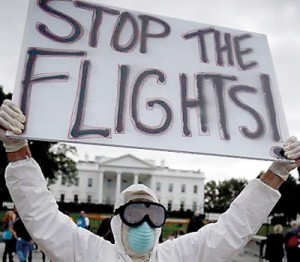Sunday Times 2
Ebola outbreak: What is the risk of catching it on a flight?
People who flew on a plane with a Texas nurse on the day before she came down with symptoms of Ebola are being tracked down by public health officials. What are the chances of catching the virus from another airline passenger?
The Ebola outbreak has caused anxiety among some airline travellers. One woman was photographed at Washington Dulles airport wearing a full hazardous materials suit.

Protestor Jeff Hulbert holds a sign reading 'Stop the Flights' as he demonstrates in favor of a travel ban to stop the spread of the Ebola virus, in front of the White House (Reuters)
On one level, it’s easy to see why fears are so widespread. Aeroplanes are confined spaces. A traveller will touch surfaces like trays, armrests, pillows and television screens that have been handled by hundreds of others.
Passengers wielding wet wipes and face masks are a familiar sight.
Amber Vinson, the second person infected in the US, flew from Cleveland, Ohio, to Dallas, Texas, on Frontier Airlines flight 1143. The US Centers for Disease Control and Prevention (CDC) said it wanted to interview the 132 other passengers.
It raises the question – how worried should they be about catching the deadly disease?
The answer, according to William Schaffner, an infectious diseases specialist at Vanderbilt University School of Medicine, is not very much. “I am sure they are concerned but the risk is essentially zero,” he says.
Likewise, the CDC says the risk to “any around that individual on the plane would have been extremely low”. This is because the virus is not airborne like flu. Anyone on the same flight as a patient would not be at risk from breathing in the same cabin air.
And it’s extremely unlikely that someone would catch Ebola from an armrest, a touch-screen television, or a tray, says Schaffner.
Instead, Ebola is spread by direct contact with contaminated body fluids such as blood, vomit, saliva and faeces. The virus can enter the body via infected droplets through broken skin or mucous membranes such as the eyes, the lining of the nose or the mouth.
The virus “is ferocious in the body but it is a wimp when it is on an inanimate surface”, he adds. “As soon as it has arrived on the inanimate surface it has started to die off.”
On inert surfaces, the virus does not last for long – “I would imagine no more than a few minutes”, according to Peter Hotez, dean of the National School of Tropical Medicine at Baylor University. The exception would be “if you see visible blood or visible secretion”.
CDC guidelines on tackling Ebola say that a carpet or seat cover that is dirty from blood or body fluids should be discarded in the same way as bio-hazardous material.
How Ebola attacks
Wet surfaces are a little more likely than dry surfaces to sustain the virus, says Dr Arnold Monto, professor of epidemiology at the University of Michigan. But someone who, for instance, sits at an airline seat previously occupied by an Ebola patient would not have cause for concern, he says.
Even sharing an armrest with an infected patient should not in itself cause someone to worry unduly. “Sweat would be a pretty inefficient way to transmit Ebola.”
The Ebola virus does not transmit very effectively until its symptoms become apparent. “People with Ebola do not become infectious to others until they become ill,” says Schaffner. Although Ms Vinson reported a temperature of 37.5C (99.5F) before flying, it appears that she was still in the early stages.
By the time a patient is likely to pass it on, they will be feeling very sick and potentially running a very high temperature – and as a result will probably not have boarded a flight in the first place. US Department of Transportation rules allow airlines to deny boarding to air travellers with serious contagious diseases.
But it’s unlikely that someone who just happened to be sitting on the same flight would have cause to worry – unless, say, they sat next to a patient in the advanced stages of the illness who vomited or bled on them.
Someone would have cause for worry, Monto says, if he or she had looked after or cleaned up after a patient sitting next to them. “If you are taking care of them, that would be a concern.”
Typically, those who contract Ebola tend to be care-givers or relatives of infected people who clean up after them.
Cabin crew are advised by the CDC to follow routine infection control precautions if a passenger becomes sick during a flight.
These include keeping the sick person separated from other passengers as much as possible and wearing waterproof gloves and surgical masks before close contact with them or any body fluids. Disinfectant should be used to clean infected surfaces.
Aircraft have a fairly good record when it comes to controlling the spread of disease, says Monto. During the recent Sars outbreak, there were very few aeroplane-related infections, despite the fact it is transmitted through the air. “Given the amount of cases in Asia, it was relatively infrequent,” he adds.
(Courtesy BBC)

